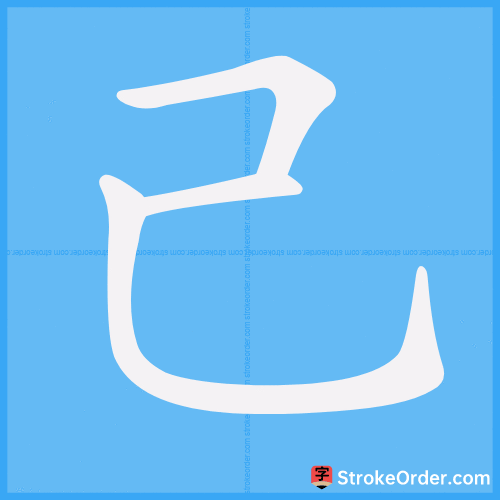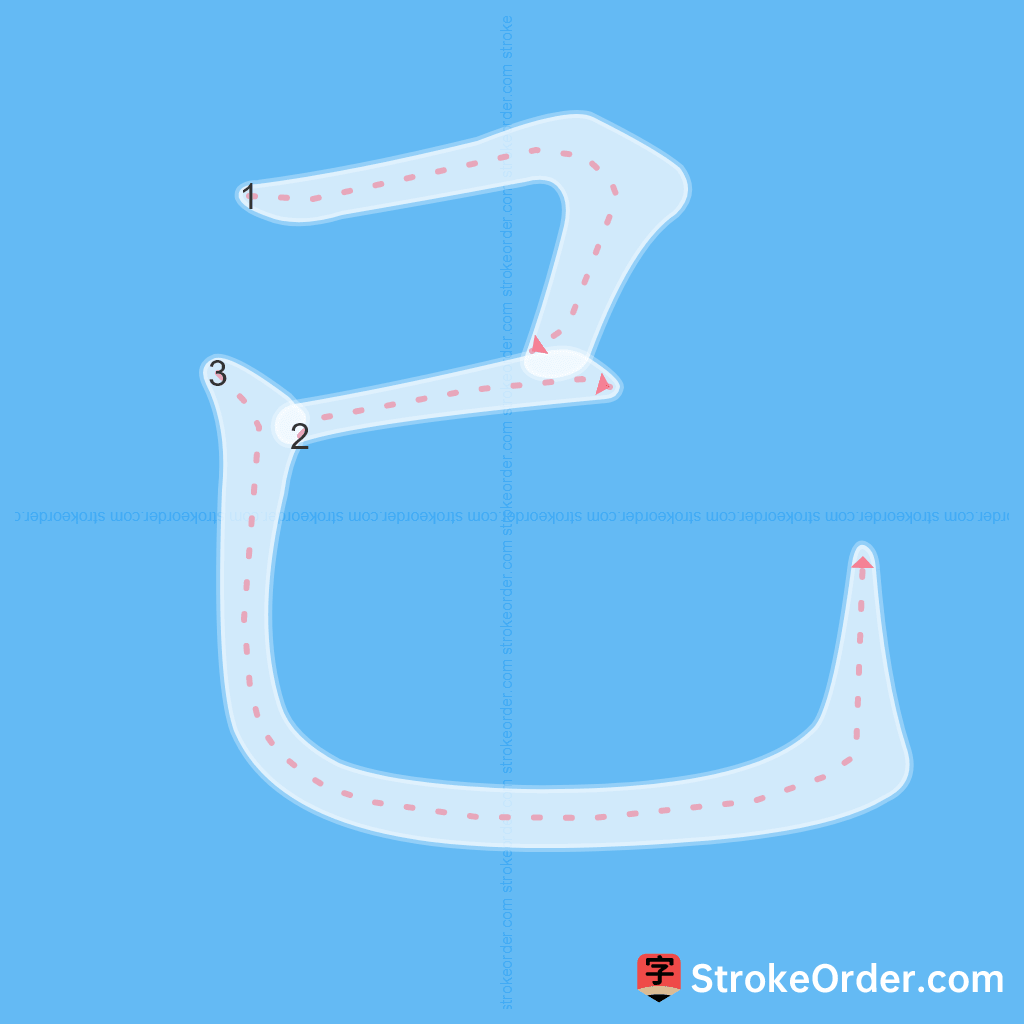己 Stroke Order
Animated Stroke Order of 己

Stroke Order Diagrams for 己

Step-by-Step Handwriting Guide for 己

Learn to Write Chinese Characters with Video Tutorials
Watch the video of writing the Chinese character "己", learn the correct stroke order (笔顺) of the character "己", and master the standard way of writing the character "己".
Free Printable Handwriting Practice with Stroke Order: 己
Printable Writing Practice Worksheet of "己" in Portrait Orientation (Tian Zi Ge)

Printable Writing Practice Worksheet of "己" in Landscape Orientation (Tian Zi Ge)

Information of 己
Pinyin
jǐ
Radical
己
Strokes
3 strokes
Usage
★★★★★
Definition
6th heavenly stem / self
己 [jǐ]
1. Pronoun: Referring to oneself.
- 自己 (oneself)
- 知己 (know oneself)
- 反求诸己 (to reflect on oneself)
- 推己及人 (to extend oneself to others)
- 己所不欲,勿施于人 (what you do not wish for yourself, do not impose on others)
2. Noun: The sixth of the ten Heavenly Stems.
- 天干的第六位 (the sixth of the ten Heavenly Stems).
3. Verb: Used as a variant of "给" (give).
【Original Meaning】: The head of a thread, used for binding.
【Character Formation】: Pictographic. The shape of the oracle bone script resembles a twisted rope. "己" is an ancient form of the character "纪," borrowed to mean "oneself."
Examples and References:
1. 孙子兵法: 知己知彼,百战不殆 (Know oneself and know the enemy; in a hundred battles, one will never be in peril).
2. 吕氏春秋·察今: 而己亦人也 (And oneself is also a person).
3. 晋·干宝《搜神记》: 自拟己头 (To imagine oneself).
4. 唐·柳宗元《三戒》: 且噬己也 (And to harm oneself).
5. 宋·范仲淹《岳阳楼记》: 不以己悲 (Not to grieve for oneself).
6. 宋·王安石《游褒禅山记》: 在己为有悔 (Regrettable for oneself).
Additional Examples:
- 舍己为公 (self-sacrifice for the public good)
- 异己 (other, different self)
- 克己 (self-discipline)
- 知己 (an understanding of self)
- 己身 (oneself)
- 己私 (one's own desires)
- 己里钱 (blood-sweat money, private savings)
References for the Sixth Heavenly Stem:
1. 吕氏春秋·慎行论: 己与三相近 (Ji is close to the three).
2.甲乙丙丁戊己庚辛壬癸 (The order of the Heavenly Stems: Jia, Yi, Bing, Ding, Wu, Ji, Geng, Xin, Ren, Gui).
Verb Usage:
- Used as a variant of "给" (give).
- Example: 一二千两银子东西己人!叫他唱二万出戏我看了,己他一个! (One or two thousand taels of silver ought to be given to someone! Let him perform twenty thousand shows, I've seen him do it!)
know yourself, know your enemy (idiom, from Sunzi's "The Art of War" 孫子兵法|孙子兵法[Sun1 zi3 Bing1 fa3])
without the freedom to act independently (idiom); involuntary / not of one's own volition / in spite of oneself
Input Method for 己
Pinyin
ji3
Wubi
nngn
Cangjie
su
Zhengma
yy
Four Corner
17717
Unicode
U+5df1
Same Pronunciation Characters